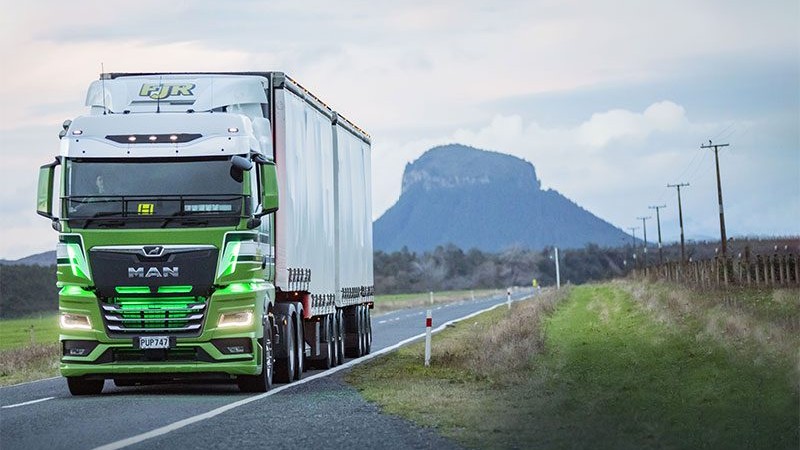
MAN’s New Generation has landed on Kiwi soil. You might at first glance see an evolution, but look closer. This is a new high- tech Lion, and resets the bar on the OEM’s range. How lucky are we that our first sample is a machine in the keep of FJ Ramsey Contracting. The Ramsey family’s livery is an industry signature, and their place in New Zealand road transport history special.
State Highway 30 is a 229km ribbon of undulating and ‘varied’ bitumen linking Te Kuiti and Whakatane. It cuts a path through the eastern King Country, South Waikato, clips the northern edge of the volcanic plateau before transiting the southeastern Bay of Plenty. It’s a picturesque drive, and for at least two-thirds of its passage imparts a level of isolation at odds with where it actually sits; a great indicator that North Island freight and people flow is dominated by north/ south traffic. Moving from the far west to far east in Te Ika-a-Maui has always been a slightly weird and arduous experience due, in the most part, to the three standalone peaks in the middle of the island and the world heritage hinterland they create.
That said, once north of Mt Messenger in the west, SH30 is one of the major routes of choice for trucks needing to effect a lateral crossing of the island. Likewise, the concentration of forest and farmland along its path bolsters the road transport industry’s patronage immeasurably.
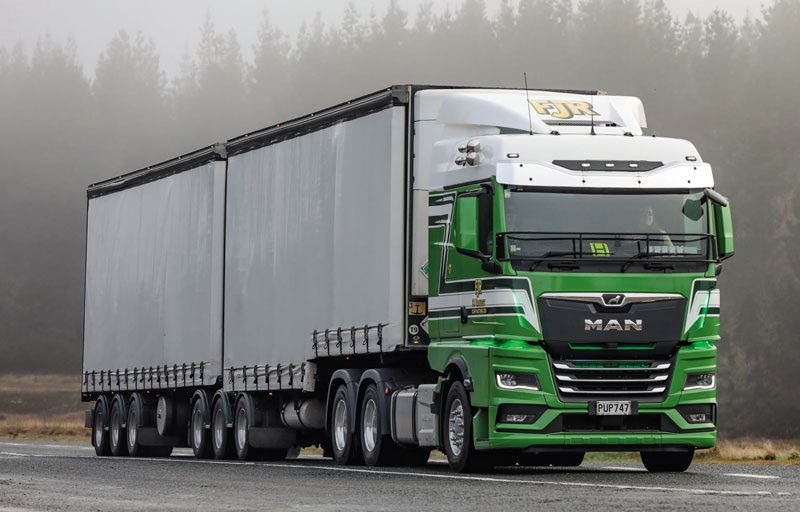
One reason you’ll go there sits about 40 minutes’ truck travel time east of Te Kuiti, just beyond the village of Benneydale – Crusader Meats. Owned by John and Bernice Ramsey, the boutique freezing works sits all on its own amid the rolling green countryside – it almost looks lonely. A sheep-processing facility predominantly, the plant can handle 3300 head a day at peak, also taking an allocation of bobby calves and goats according to seasonal requirements. John and Bernice’s two sons run day-to-day requirements: Mike manages the plant and Brent looks after sales and marketing. Daughter Vonita is not involved in the business.
Buzzing around the facility are a number of green liveried trucks and it’s no coincidence they bear a striking resemblance to those famous machines of years gone by owned by Rotorua- based Ramsey Roundwood. Yes, these well-respected Kiwi innovators and entrepreneurs have divided their commercial life between posts, poles and protein, and the two-tone green-and-white liveried trucks of FJ Ramsey Contracting have been a common thread in both enterprises.
We’re at Crusader Meats at 5am on a ‘bracing’ late autumn morning to sample our first New Generation MAN TGX, in 26.640 trim. What’s even more exciting is it’s towing a B-train, and those who know their road transport Kiwiana will chuckle when we say no MAN has more right to tow a B-train than those of FJ Ramsey. John Ramsey spun heads back in 1981 when he commissioned the country’s first on-highway B-train – at the time an odd-looking Canadian-born trailer setup where one semi-trailer towed another. ‘It’ll never work!’ – LOL.
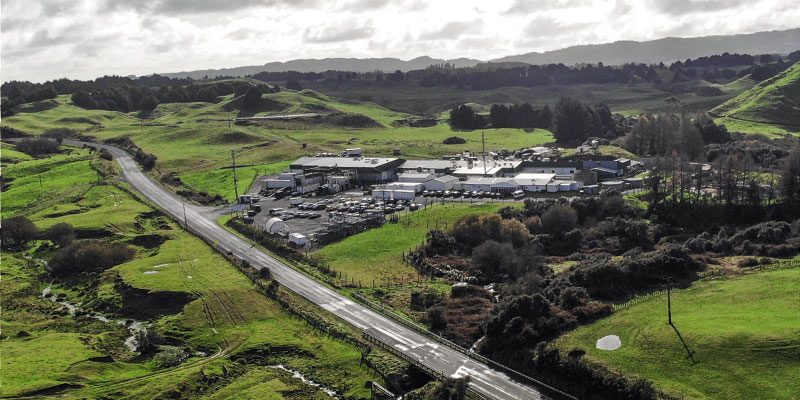
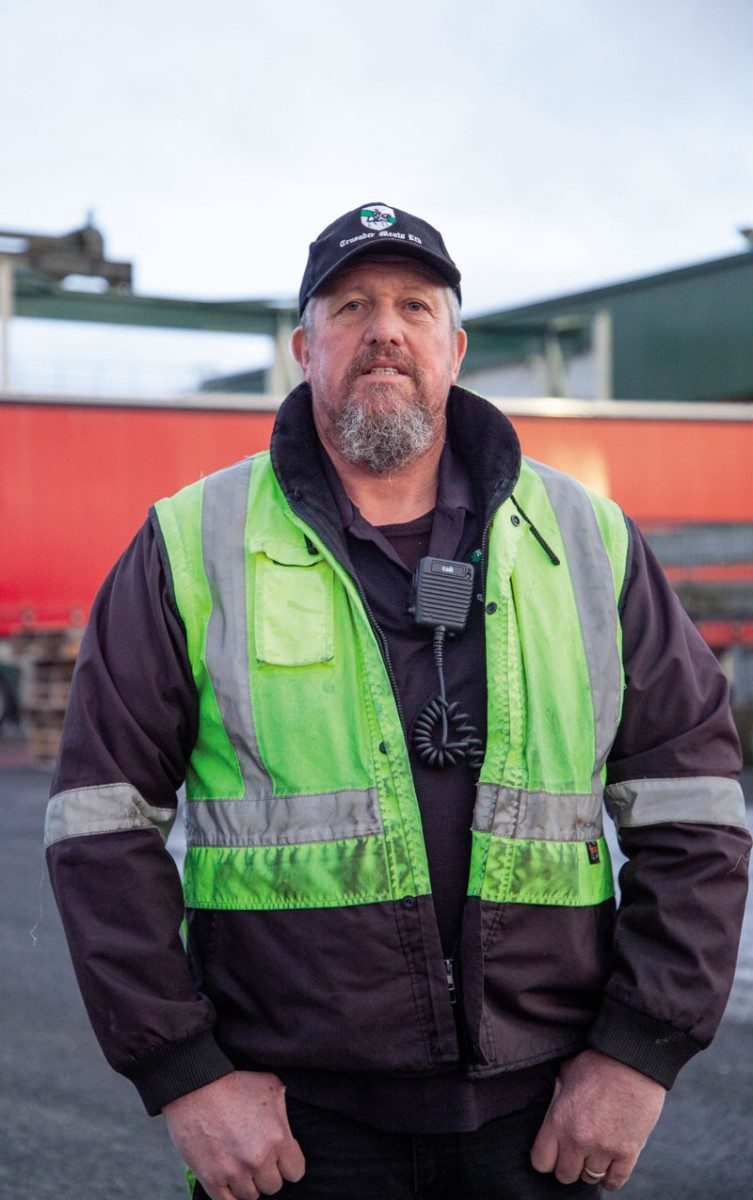
A beast for the east
Crusader’s product leaves the Benneydale plant either containerised, in stillages, or palletised cartons. Containers go on skeles, the latter two in chilled curtainsiders. Traditionally, all product was routed through Mt Maunganui, the bulk carted by local carrying identity PGF, with a little in-house. However, as we all know, in the ebb and flow of business, nothing is ever the same for long. About three years ago, a major reallocation of cool store space at Mt Maunganui resulted in Crusader’s supplier losing its China-certified site and an alternative had to be found for the company’s China-bound product. That came in the form of Whakatu Cool Stores in Hawke’s Bay, which set in motion a restructure in how product was shipped.
Up until then the China and rest-of-world product was shipped ex-Benneydale to Mt Maunganui in cartons loaded into stillages ready for immediate blast freezing. Post the upheaval, eastbound loads take the form of wrapped pallets, repacked for freezing once at Whakatu. Payloads have increased from 18 to 30 tonne, so any increase in handling charges is balanced by volume moved.
Ramseys took on the Hawke’s Bay transport task themselves, sourcing and reconfiguring a six-axle B-train to better exploit HPMV opportunities.
“You could argue the case for more payload in an eight-wheeler and five-axle truck and trailer,” said Mike, “but you lose versatility. We have other B-trains and a skele, so need the trucks to be flexible.
“The B-train is configured with mezzanine floors on the gooseneck, not just the main bodies. Because the product is not frozen in transit, we can only stack boxes six high on the pallets to preserve the carton integrity. Having the ‘mezz’ up front gets us to our target 57-tonne HPMV weight.”
With moderate weights and the Kaimai Ranges providing the only decent big climb en route, the company’s 2019 MAN TGX 26.540 is ideal for the 338km return run to Mt Maunganui. But running the 519km return to the Hawke’s Bay six times a week at 57 tonne, with more robust climbs than you can shake a stick at, and you’re in a different league of truck requirement.
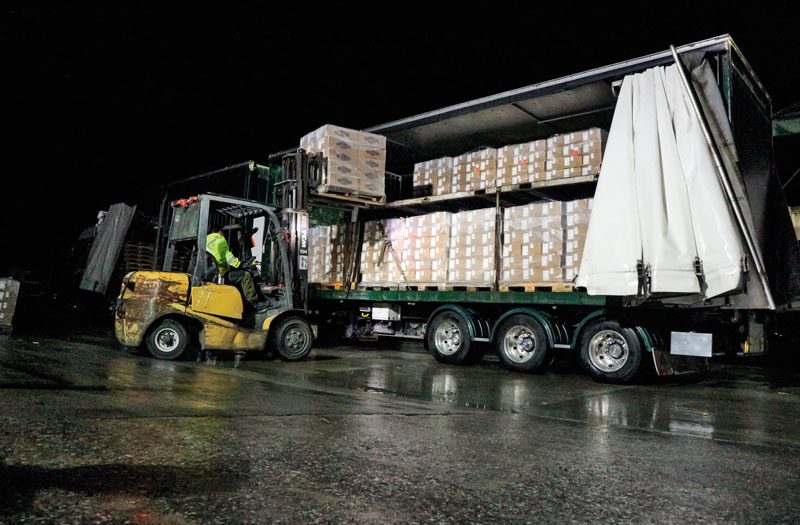
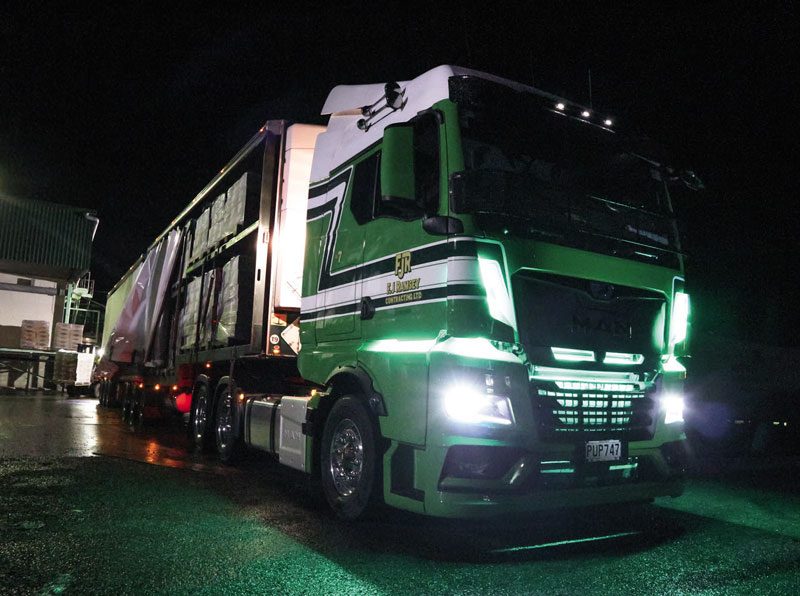
To be fair, the 540’s been carrying the Olympic torch on this one admirably while the 640’s been in the incubator, although driver Colin Edwards said it’s certainly not a fast trip. “Even on a like-for-like trip to the Mount the 640 is 15 minutes ahead. The 540 will still do the sixth trip to Hastings each week, which is fine. She’s just not going to break any records.”
When we arrive onsite, Colin’s already well into the loading operation and he’s fully briefed on our impending arrival. First impressions count, and we knew from the outset we were in for a great couple of days with a neat bloke, in a cool truck.
Colin’s that full of trucking pedigree it’s oozing out his tear ducts, although you’d have no idea when you meet him. He is to ‘FIG JAM’ what the Pope is to UFC, however the tell-tale signs appear early. Pallets exit the factory on a conveyor and Colin plucks them off with a fork-hoist. Each pallet is placed, tucked sideways, and dropped the last 5mm to the deck and then he backs out. There’s no revving, frantic side-shift mayhem or pallet scuffing, it’s all calm. Every now and then, he’ll leap off and move a strap he’ll know will be in the way in three pallets’ time, tighten a mezz-support strap, or close up a curtain, allowing the smooth flow of operations to continue. By the time we get to the last two pallets right up the front, the rear unit is closed, buckled and ready. There’s about 10mm tolerance to the headboard … and in they go. We’ve chatted all the way through and there’s not been a single moment of tension or frustration, no poles lying around, or loose straps snaking out across the yard. It’s an old trucking adage happening before our very eyes – speed comes with smoothness, not haste.
Sitting ahead of the combination in glorious green is one of the world’s state-of-the-art diesel combustion heavy trucks. Known colloquially in the ‘frat’ as TG3, MAN’s New Generation TG range can only be described as a revolution of evolution; its origins instantly apparent in an unrecognisable way. In that regard MAN and Kenworth have something in common, the ultimate evolvers of their respective form factor.
Visually it’s a MAN, no mistaking, however once harsh lines are now smooth and cohesive. It’s like they sent old TG to a Malibu cosmetic surgeon and asked for a tighten-and-tuck job. That makes TG slipperier in the air, and that’s good for consumption. MAN reckons the whole package – aero, driveline, smarts, driver training – could add up to 8% over previous incarnations.
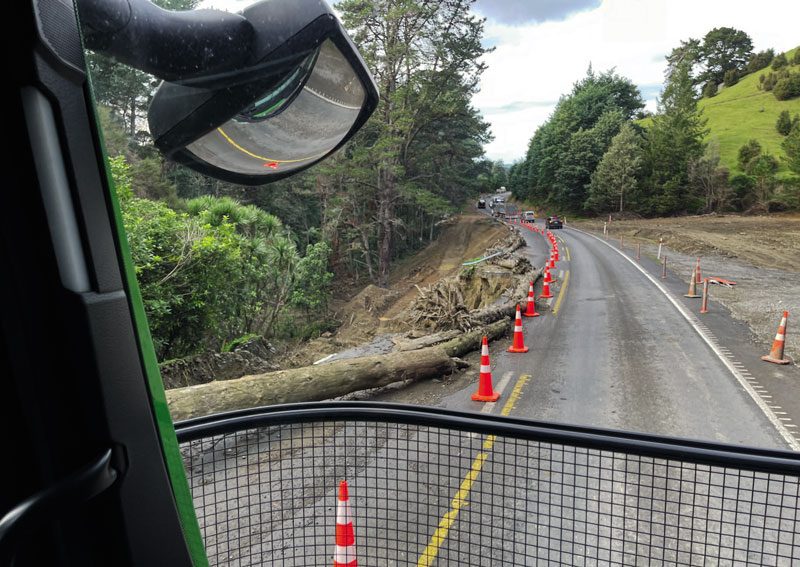
Readers may remember I was privileged to be able to follow the New Generation MAN through its global birth and attended both the Munich launch in 2019 and then the big drive event in Spain in 2020. It is a truck I feel I know. In respect to the cab, I remember MAN boss at the time Joachim Drees saying the externals got a smarten up so the bulk of the budget could be sunk into the cab’s internals and the tech unseen. There was no escaping the message at the time; New Gen TG was a truck in preparation for a different tomorrow.
Munich to Benneydale, and here was the New Gen TG in TGX form as far from its birthplace as any MAN will ever get, about to head off on some pretty testing Antipodean duties.
“MAN. We bought our first one in 2019, a TGX 540, and that’s been a good truck,” said Mike. “I wanted something European with a good retarder. Availability at the time was immediate, and the Kerley boys up the road recommended them based on their experience. We decided on the 540 and it hasn’t given us any trouble to date, with 200,000km on the clock. Penske has been fine to deal with, so when we wanted something better suited for the Hawke’s Bay work, we thought we’d go for another. We dealt with Mitch James in Mt Maunganui and he was all good. No problems at all.
“There’s no easy way to get out of here to the places we need to get to. It’s tight, windy, and hilly, and with the increased weight, distance, and workload involved in the [Hawke’s] Bay run, we thought we’d up the power and engine size to the 640.”
It’s still a Lion – thank goodness!
The New Generation MAN was a complete range overhaul. As Drees said at the launch, that is rare … and expensive. The reason for the blanket approach was down to something he called EE, or Electric and Electronic architecture. A decade in research and development with 1.2 million lines of software code written in-house, EE unifies, and therefore simplifies, the underlying electrical and electronic architecture of the truck. According to head of the EE system Stefan Teuchert, many safety and productivity systems in trucks run on standalone hardware each with their own operating systems, all trying to communicate. It’s especially so when integrating third party systems.
The New Generation MAN eliminates all that, with a single operating system controlling the whole show in an architecture infinitely simpler and more reliable. It allows greater levels of communication between systems, easier updates, and the downloading of future safety and productivity applications with no disruption to the truck’s workflow.
“Think of it as a giant smart phone,” said Frederik Zohm, board member for research and development, meaning there’s one central brain running the show and bringing it all together.
With such a bevvy of tech, there’s an incredible stash of data to be plundered also. Dean Hoverd, Penske’s national sales manager for New Zealand said the company was evaluating a telematics solution currently – watch this space.
The good news is, techy and swanky as it might be, New Gen TGX is still a Lion at heart. We’ve always loved the exhaust note of MAN trucks, and the company hasn’t dropped the ball on its entrant into the Euro-6e offering at all. Waiotahi Contractors, and the Harte’s 15.2L MANs had it … that big six-pot locomotive ‘thump thump’, and the Ramsey machine continues the tradition. The sort of sound that makes you believe your machine’s up to places like the Napier-Taupo Road at 57 tonne.
Closed up and paperwork done, Colin rolled away from the load-out pad to the gate, and turned left. As Jerry Reed so famously coined, ‘Eastbound…’
The 15.2L D38 is a genuine 3000Nm engine. It’s not punching at the same level as the biggest on offer, but once you’re in that torque league, progress is rarely impeded by a lack of output.
D38’s the biggest of a three-engine line-up for the TG Series in the industry norm of 11- (10.5), 13- (12.4), and 15- (15.2) litre displacement. A six-cylinder common rail unit deploying EGR and SCR to get to Euro-6e with CRT (continuous regeneration trap). With two-stage turbo charging (low and high pressure), MAN is happy for you to run your D38 on paraffinic diesel fuels (DIN EN 15940) e.g. hydrotreated vegetable oils, if you’re feeling that way inclined.
She’s a ‘grumbler’ too, with a peak torque of 3000Nm (2213lb/ft) from 900rpm to 1400rpm handing off to power at 440kW (590hp) on its way to the 471kW (640hp) peak at 1800rpm.
Colin’s right into training the motor to operate where it should be too, and on a couple of instances, he let it loaf over the crest of a climb at 1000rpm. It sounded superb and untroubled.
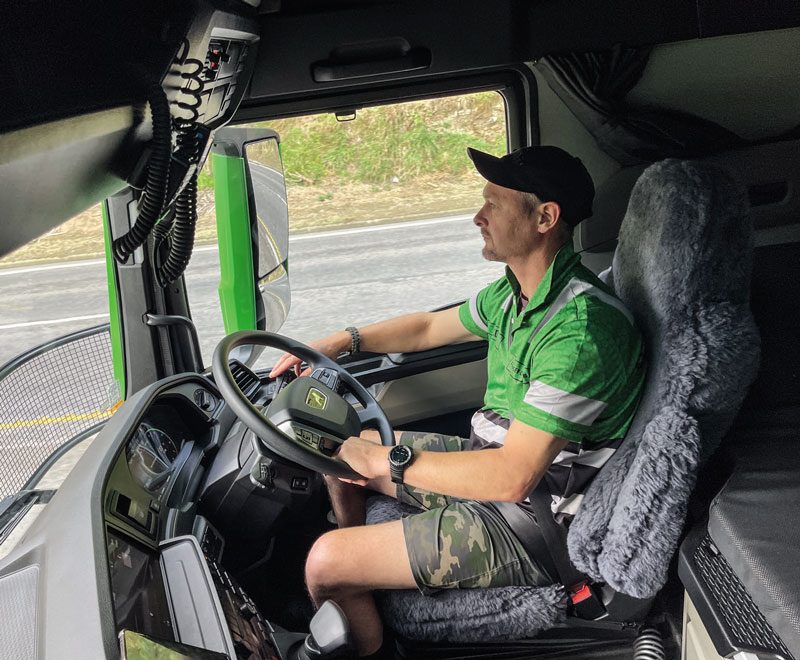


“I’ve been driving it in manual a bit, just to see what it is capable of, and because it gives me something more to do,” he said with a laugh.
Behind the six big pots is the MAN TipMatic 12-speed OD AMT with Retarder 35. Again, a MAN-configured ZF TraXon answering any questions on capability and smoothness. Out back, MAN HY (Hypoid) HYD-1370 and 1350 differentials – at 3.08:1 with locks on the rear axle – sit on eight-bag MAN ECAS suspension with stabiliser bar and shock absorbers. Up front, parabolic springs, again supported by stabiliser bar and shock absorbers, bear the load.
The trip out to SH1/30 at Atiamuri is a ‘wits-about- you’ affair, beginning with rolling country, then crossing Whakamaru Dam before swinging left and skirting Lake Whakamaru until the junction about 25km further on. Along its entire length, SH30 is a road that varies in width constantly, and just when you’re feeling comfortable, all of a sudden it narrows up again. Classic Kiwi carriageway! The section along the side of the lake towards Durham Point is one such spot. “Along under the cliffs, you can even have the occasional boulder sitting in the road,” said Colin.
Turning right out onto SH1 and we bid 30 farewell. It is straight into the base of the Atiamuri climb proper, and as fresh as the MAN is, at a mere 13,000, it shows its class, accelerating smoothly away and up the climb past the Atiamuri Dam.
At a power to weight of 8.3kW/tonne (11.1hp), it is north of the magic 10hp/tonne, but its life will in no way be a romp in the park. What will make the power all the more effective is the torque base of 52.6Nm/tonne (38.8lb/ft), providing a solid platform from 1400rpm down.
A cup of tea at the Z Taupo, looking out the window at the unit, TG3’s side profile is classic MAN – big and boxy. The six-axle Roadmaster B-train was bought secondhand and refurbed at Racewell Engineering, Te Kuiti. It’s a really nice clean job, and Racewell also did the alterations, adding the front mezzanines. Mike has sourced a second set, only six registrations different from these ones, to go behind the 540 MAN. “They’re getting a birthday now,” he said.
‘Go east, big green MAN,’ was the call and so it did. Catching a elderly Fuso suffering a bout of ennui on the climb to the Rangitaiki Plains hammered home what it is modern high-output machines deliver. Inside the cab, it felt like a big truck climbing a hill always has done, the lovely engine note doing enough to entertain us at around 68-odd dB. There was no need for raised voices at all. It’s not until you encounter loyal Trojans of a more modest output doing battle with Newton’s laws that you realise how quickly and effortlessly the heavy hitters of today deliver the goods. Imagine telling the Neil Otways and John Mettams of the late 1960s/early 1970s how fast 57 tonne would get from Taupo to Napier one day.
Cruising past the High-Level Road and the hallowed ground that was 60/8 weighbridge, there’s barely a whisper in cab. A finalist in this year’s Truck of the Year Australasia, the TG3 package has all modern safety and productivity apparatus: adaptive cruise, automatic emergency braking, lane guard, lane change and turn assist, easy start (hill launch control) headlights that peer around the corner with you in the dark at under 40km/h … it’s all there. And of course modern productivity enhancers like efficient roll, which no doubt contribute to the MAN’s early consumption of 1.67kpl, not bad considering youth, gross weight, and route.
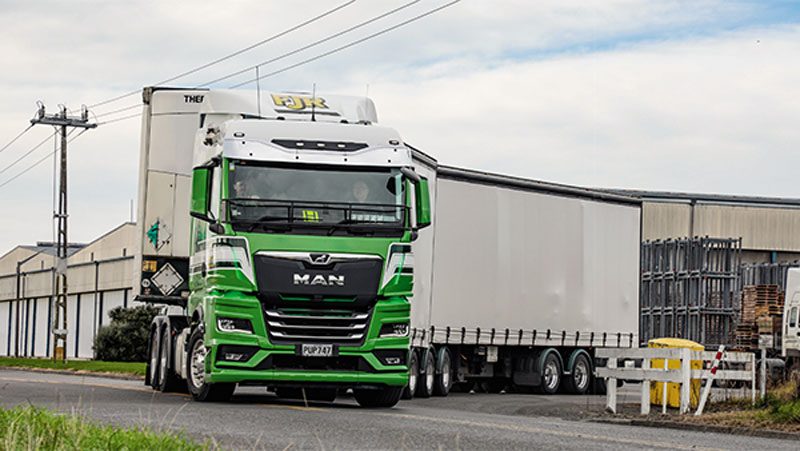
…and down!
As painful as the 80km/h speed limit on the Napier- Taupo Road is for light traffic, for trucks – especially ones in this league – it’s no real biggy. Sure, old mate in the Fuso might be pissed he can’t get a blinding run at some of the hills, but the MAN’s ascension probably won’t be overly affected, neither will the trip time.
Through the Waipunga, Colin points out the areas he’s been hunting in. The MAN easily pulls around the hairpin on Tawarewa, up and over the top, down and on through the Stoney Creek section.
Turangakumu next, the first of the big open climbs. The MAN dips momentarily to 22km/h at 1050rpm in seventh on the steepest pinch before recovering to 29–30km/h for the majority.
One of the key reasons behind wanting to go European for Mike Ramsey was the retarders available in this genre of machine.
I’ve made my thoughts on retarders well known over the years. They are a phenomenal tool for safe and controlled descending, and in conjunction with modern, electronically controlled heavy vehicle brake systems, you can reduce altitude at speeds previous generations never enjoyed.
However, stopping distance is still the meter of descending speed, not the capability of the retarder. Sailing off big climbs at high weights and absurd speeds just because the retarder will hold you will eventually earn you an appointment with a judge, where he will hear you say, ‘there was nothing I could do’, at which point the prosecution will sneeze ‘bullshit!’
Colin’s schooling in the art of truck driving was about as good as it gets, having been tutored at the hand of his uncle John Lockley in Waihi. He’s a true disciple of the golden rule – although our desire to overcome inertia will always be a constant war, the need to instantly arrest impetus must be an imperative.
We glided through Te Haroto and Colin set up the MAN for the descent of the Kiwis.

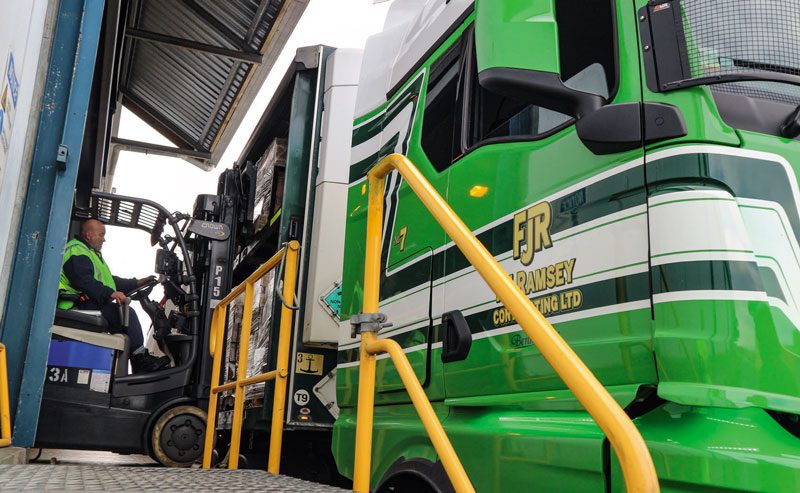
“It’s bloody phenomenal,” he said. “Don’t get me wrong, the Jacobs is a great tool, but your setup at the top has to be right. If you launch into something too fast the Jake won’t pull you up, not at these weights anyway. This will. In fact, if I pull this onto its highest setting, it’ll actually start slowing down, and if I hit down-shifts manually, I would eventually stop dead – even here! Even at 57 tonne. I mean, I won’t … oil temps and all that, but it would. It means if you’re in a strange area, you could go off something a little hot, and pull it back into line. That’s a comforting thing to have.”
Even taking the retarder out of the equation, the MAN’s no slug when it comes to slowing down. The EVBec engine braking alone provides 627kW (840hp) of halt to proceedings. In addition to the normal compression brake, a flap upstream of the turbo combines with targeted airflow on the intake side of the turbo, essentially increasing pressure in the entire top end – and therefore braking.
Descending control is activated via a press-on brake pedal, the truck knowing that’s your selected speed and blending up the perfect mix from that. If the truck does detect an emergency situation, then brake assist ensures 100% braking pressure during the event.
I never find the Mohaka Viaduct a heart-warming experience. Narrow and out of date, the panic at times in recent years over its structural integrity doesn’t really fill you with unfettered confidence every time you approach. Another safe crossing though, and we’re soon at the foot of the mighty Titiokura. The great truck-crusher itself is today like a punch-drunk old boxer unable to deliver any real power compared with that of its modern mechanical foes. The MAN saw sixth at 1750rpm and 26km/h at the worst pinch, recovering back to the low high 20s/low 30s for the bulk of it.
The initial descent off the eastern flank is the steepest part of the entire road, according to Colin, and once again he sets the whole shooting box up for victory. Through the undulating and winding section around Te Pohue, I’m dragging my old ride chestnut out again – Euro firm. They all have it now, and a key seems to be the uber-butch stabilising setups at the front of the cabs. The MAN causes no reason to bring a bottle of Sea Legs to work, Colin pointing it where he wants, and the Lion obeying. The directional obedience no doubt helped by the 385/55 R22.5 front feet also.
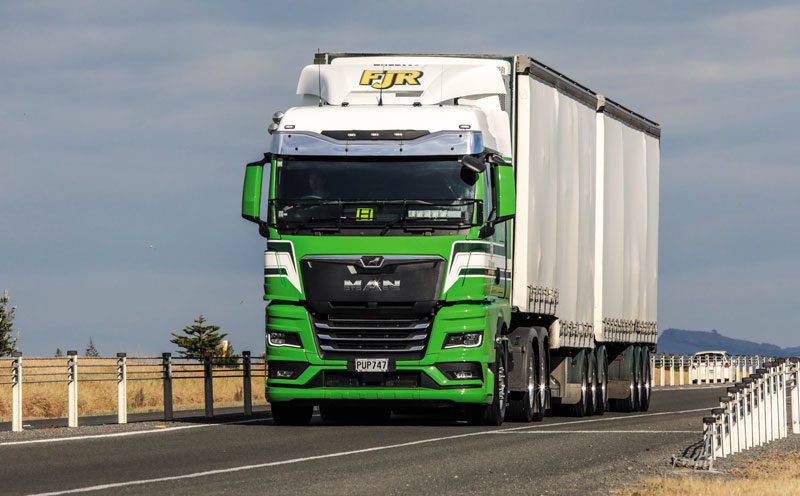

Down Eland, Glengary, and Dillons to the head of the Esk. It’s a long way down from the top of Titiokura all told, even with the respite around Te Pohue. Colin said he had seen the odd smoker arrive at the bottom, something that sends shivers through your timbers for sure.
I’m going to keep well away from what I witnessed as we rolled down the Esk Valley. Right or wrong, I think it is disrespectful. All I will say is, as a nation, we need to pour assistance into this region at the level we did with Christchurch.
Pulled in alongside the cool store dock, the TG3 sat there as if nothing at all had happened. Colin whipped the unit open for the crew before sorting the necessary admin.
“It’s got a tonne of space. When you whip the passenger seat around it creates that much more room in the cab to move around in. It’s easy to stay in there’s no question,” said Colin. “The whole project has been great. Mike’s let me have some input and anything I wanted on the truck within reason wasn’t a problem. I’m rapt with how it’s turned out and the feedback I get.”
As he accessed the side lockers for something, I remembered saying at the launch in Munich that I thought they were set a little high, and OEMs are not generally giving consideration to shorter folk, female drivers in particular, when they design these things (before you start, global stats cite the average height of women at 13cm shorter than men). The European entourage were intrigued and amazed, by all accounts the fairer sex and truck driving aren’t a thing in Europe. They quizzed me intently on their capability, to which I replied – bloody awesome. You should try it.
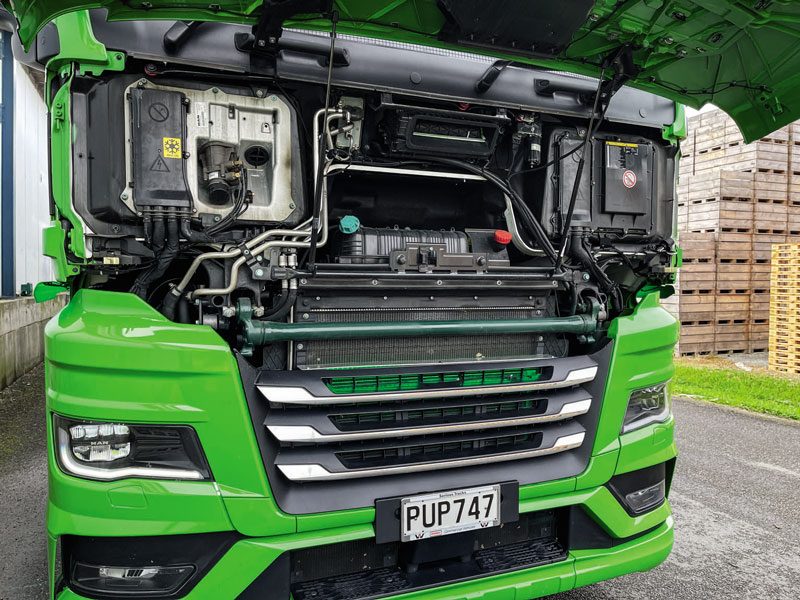
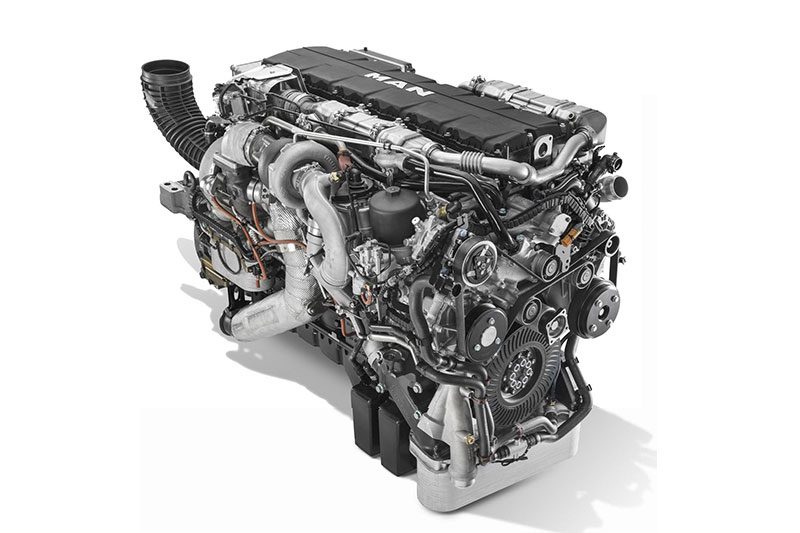
Cyber buddy
Speaking to history, we are likely approaching the zenith of what happened with diesel. All we’ve achieved in our desire to clean up and improve the efficiency of an extremely grubby explosion in a primitive steel crucible over the last half century is akin to a miracle. Sadly, those who pulled off such a feat of chemistry and engineering will never receive the accolades they deserve. In fact, they’re increasingly seen as pariahs by those who gained most from the riches their creations reliably delivered to us.
The New Generation MAN TGX and D38 combo is a fine example of state-of-the-art diesel combustion in the 21st century. A fantastic Euro-6e machine able to deliver performance once thought impossible, at a fuel consumption rate that would have had you labelled at best a lunatic, at worst a heretic, in times past. And it all takes place in a level of driver comfort no mansion back then could boast.
In New Generation, MAN has taken a hatchet to the inevitable complexities that build up over time in the race to improve amid fierce competition. This is a clean truck, not just in the sense of emissions, but also in the architecture that delivers so much of the mysterious technological miracles that make it relevant. This should be one of the most electronically reliable, and easily managed trucks ever built.
Yet for all of the above, the underlying machine is actually one prepared for another time, one we’re yet to see and enjoy.

Quick reads from Tests
Read more
The right man for the job
0 Comments29 Minutes
Legendary ambition
0 Comments36 Minutes
Hard Fought!
0 Comments40 Minutes
Postal Trifecta
0 Comments29 Minutes









